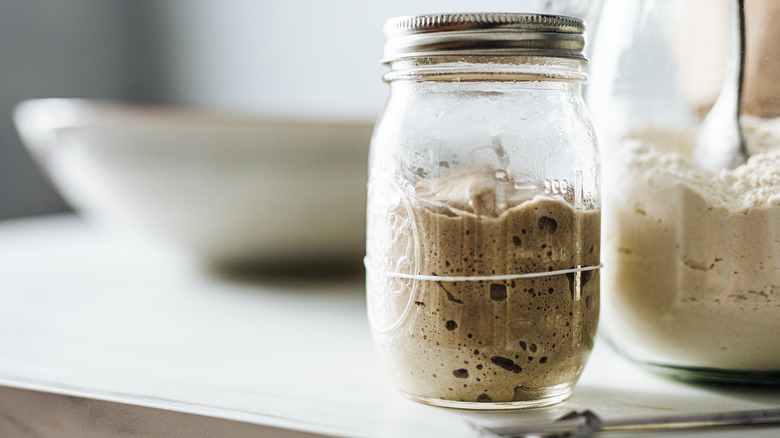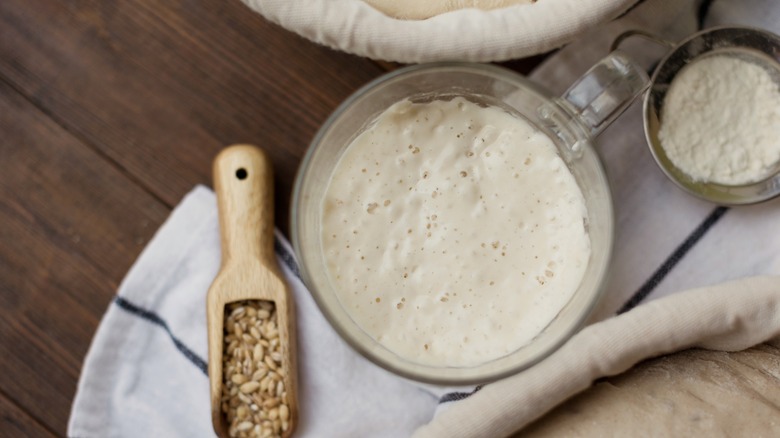Need A Break From Homemade Sourdough? Just Dry Your Starter
Making sourdough at home has been going through a bit of a renaissance in recent years. After a rise (pun intended) in homemade breadmaking throughout lockdowns, it is likely that now there are jars of starter languishing at the back of fridges across the country. While it is possible to revive starters that have been untouched for a few months, those neglected for over a year will need to be thrown out.
For those with still-active starters who may be looking for a break from the feed-and-discard cycle, there is an easy way to rest your starter: dry it. The way to do it is quite simple. First, feed the starter as you normally would to prepare for baking. Then, when the starter has at least doubled in size, set aside at least one cup. Lay a clean piece of parchment on a sheet pan, then spread the cup of starter over the parchment as you would jam on toast, though as thinly as possible. Place the sheet pan with the starter in a dry corner of the house and leave it to dry until fully dehydrated; this can take several days, depending on the temperature and humidity of where you live. Once the starter is dried, break it apart into shards and place it in an airtight container. This dried starter can now be stored in a cool and dry place until you want to revive it for future batches of homemade bread.
Reviving a dried sourdough starter
This knowledge of what goes into making sourdough starters can be transferred to reviving or reconstituting a dried sourdough starter. Dried sourdough starters are essentially dormant yeasts that need to be "woken up," so you need to provide an environment to encourage that. When it's time to revive dried sourdough starter, here's what to do.
Using a kitchen scale, measure about an ounce of dried starter shards into a pint-sized glass jar along with two ounces of room-temperature water. Stir it all together with a clean spoon and leave it for as long as it takes to rehydrate, usually about three hours. Once it becomes liquid, add an ounce of unbleached all-purpose flour and stir it well. Loosely place the lid on the jar and leave it in a warm spot for about 24 hours. You should see little bubbles begin to form at this point. Add another ounce each of water and flour and mix — do not discard any of this mixture. When it starts bubbling actively (about eight hours or so), stir in another ounce each of water and flour, without discarding any. After about eight to 12 hours, the starter should be bubbly again, with evidence of it having risen and deflated (this is normal!). At this point, you can resume your starter's regular feeding schedule and use it as you did before it was dehydrated.
Staying excited about sourdough starter
Why dehydrate a sourdough starter in the first place? Why not just throw the whole thing out if you want to pause baking and make a new starter when the inspiration strikes again? Well, a robust and active starter is a valuable thing, in many cases having captured wild yeast from certain locales and certain periods of time in history. Additionally, while making and maintaining a sourdough starter is quite simple, the amount of effort it takes and starter discard that is kept tends to inspire a certain kind of attachment to one's starter, much like you might have with a pet. So, it makes sense to preserve that effort for whatever reason, whether it be a vacation or to transport the starter to share with another person.
If, for any reason, your dehydrated sourdough starter does not revive to previous levels of activity, you are still able to use it like you would regular sourdough discard in various ways. Add them to any recipe that already has leavener (as this discard will not be able to make it rise) to add that signature lactic acid tang, from crackers to English muffins and even chocolate chip cookies.


